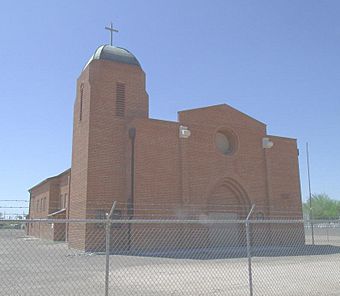Sacred Heart Church (Phoenix, Arizona) facts for kids
Quick facts for kids |
|
|
Sacred Heart Church
|
|

Sacred Heart Church
|
|
| Location | 920 S. 17th St., Phoenix, Arizona |
|---|---|
| Area | 0.2 acres (0.081 ha) |
| Built | 1954 |
| Architect | Albert Braun |
| Architectural style | Modern Movement |
| NRHP reference No. | 12000124 |
| Added to NRHP | March 20, 2012 |
The Sacred Heart Church, also known as the Historic Sacred Heart Church, is an important building in Phoenix, Arizona. It is located near 16th Street and Buckeye Roads. This church is no longer used for regular services.
In 2012, the church was added to the National Register of Historic Places. This was thanks to the hard work of the Braun Sacred Heart Center Inc. The land where the church stands is owned by the City of Phoenix Aviation Department. Sacred Heart Church was a very important part of the Golden Gate Barrio neighborhood. Even today, the Braun Sacred Heart Center Inc. holds a special Christmas Day Mass there every year for people who used to live in the area. This tradition has continued since 1987.
Contents
A Look Back: Sacred Heart Church's Story
Around 1950, a man named Victor Stinger gave a small piece of land in Phoenix, Arizona. This land was meant for Catholic services for the people living in the Golden Gate Barrio and nearby areas. The very first church building was simple. It was a ramada, which is like a shelter with a dirt floor and a roof made of palm leaves.
Building the Church with Father Al
The building of Sacred Heart Church is mostly credited to Albert Braun. People knew him as Father Al. Around 1952, Father Al started working with the community. He asked to stay in the barrios until his work was finished. He didn't want to be moved to other places.
Father Al held his first church service under the ramada on August 10, 1952. He continued to hold services there for two and a half years.
Community Effort and Construction
During this time, Father Al worked to get more land. He also started a special fundraising effort in the Golden Gate Barrio. Every single person, even children, bought at least one red brick. This happened after a rainstorm ruined their supply of adobe bricks.
With an $8,000 loan from the Bishop of Tucson, the rectory (the priest's house) was finished on March 15, 1954. Two smaller chapels were also built. Saint Isabel (later called Saint John's) opened on March 18, 1954. Saint Mary Magdalene opened on May 17, 1954.
Only after these chapels were built did the main church construction begin. Bishop Gercke blessed the completed church on October 14, 1956. Work on Santa Rita Hall started in November 1956. This hall was built to serve the residents of El Campito and was finished in 1957. The church's altar, made of Italian marble, the roof, bell tower, and copper dome were added soon after. Father Al left the parish in 1962. However, he remained involved with the church until he passed away in 1983.
In 1985, the Diocese of Phoenix sold the church to the City of Phoenix Aviation Department. This was part of a project called the West Approach Land Acquisition.
Sacred Heart: A Community's Heartbeat
Even though Sacred Heart Parish was not a wealthy church, Father Al made sure it helped the community. He had two active church members, Ramon Arvizu and Pete Avila, get special training. They learned how to help local families who didn't have enough food or good housing. Ramon Arvizu was the father of Abraham F. Arvizu, a well-known community leader in Phoenix.
Father Al and the church members also worked on other important community needs. They helped get better lighting, paved roads, and sewage systems. A worker from a local court even said that after Father Al arrived, fewer young people got into trouble. This was because people in the community started working together like a big family.
Why Sacred Heart Church Matters
Historically, Sacred Heart Church is the very last building left from the original Golden Gate Barrio. This neighborhood was once home to nearly 6,000 people. However, in the 1970s and 1980s, these residents had to move from their homes. This happened because the land was needed for the expansion of the airport. This process is called "eminent domain," where the government can buy private land for public use. The church stands as a reminder of this important community.

